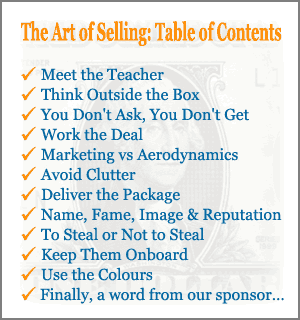
|
|

The Art of Selling: Sponsorship 101
|
|
|
By David Cameron, Italy
Atlas F1 Magazine Writer
|
 Table of Contents includes links to each chapter
Table of Contents includes links to each chapter
|
|
Most of the teams are identifiable by their colours - Ferrari is red, McLaren is silver, Jordan is yellow, and so on. The move to blue and white reflected BMW's racing history (and, to a small measure, WilliamsF1's own), but this move has molded the team into an identifiable package, a brand, which has a flow-on affect on the team's merchandising and branding. It helps make the team itself easier to sell.
"I think it's the future of sports marketing, and in some areas we're well ahead of some of our competitors in this. "If we compare ourselves to football again, in sponsorship we're miles ahead of football in terms of understanding, but conversely I think some football clubs have been well ahead of us in merchandising and licensing. We're catching up, and we've made mistakes - we first started trying to tackle merchandising and licensing as early as 1997 when we first started a concerted effort on our M&L programme. We made mistakes but we learnt from our mistakes, and I think we probably have the most sophisticated M&L programme now in the Formula One paddock. "And that helps form a brand - the imagery of the team, the blue and white colour code, the portfolio of sponsors and then the merchandising and licensing, which is carried through to point of sale, carried through to the fans around here and whatever - all that builds up this brand identity. And we've been careful to preserve that, and to encourage it, to the point now where that's identifiable. "There was a survey recently of the ten biggest sports brands in Europe, and unsurprisingly Ferrari was number one overall, the major football clubs were there - Manchester United, Real Madrid, Juventus - and we were sixth; we were chuffed with that, really chuffed.
"We're now in the high street, selling products with the Williams F1 brand on it, and if you'd asked me five years ago if that's possible I'd have laughed. But I think there's credibility in our brand, and because of that there's certain implications whereby putting our name to a product helps it sell, gives it a value. No one's cracked the global high street yet, and again I'll compare us to football - if you go into any shopping centre in the UK, Europe, or South America you will be able to find football strips for sale, replica football strips. And you can't do that with Formula One. "Will that come? I'm not sure, because football is more tribal than Formula One, and I think a lot of fans come to a race without a particular allegiance to a driver or a team - they come here because they just want to see Formula One, as they do for tennis or golf. I think it has become a little more tribal recently, and that has to do with the brands becoming stronger and the identity with certain drivers - and people like Michael Schumacher staying with a team for ten years and whatever helps build that. "But I think the major breakthrough will come when the major sports brands - Nike, Adidas, Puma or whatever - come to Formula One and say 'right, we've done football to death and there's little or no room for expansion here - Formula One's the next one'. And if they got hold of it and starting running Formula One then I think you'd see a different story. They won't do that with any tobacco-sponsored teams - there's too many problems with regulations - and I think it's generally harder to do with Formula One. If that came then I think you'd see a major difference; I think you'd see a big leap for Formula One." © 1995-2005 Kaizar.Com, Inc.
. This service is provided under the Atlas F1 terms and conditions.
Please Contact Us for permission to republish this or any other material from Atlas F1. |
|